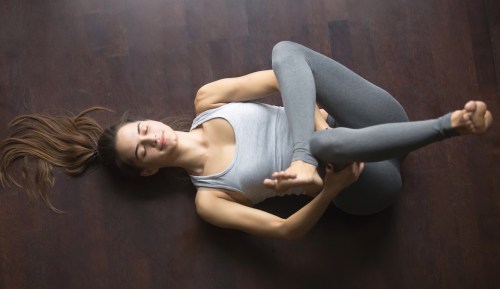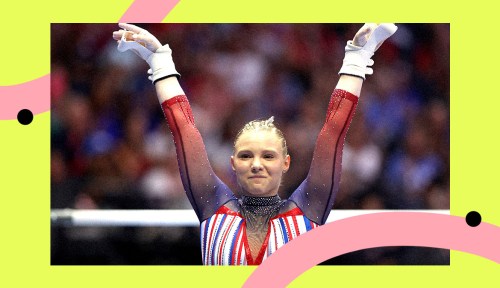A good stretching session makes everything better—you know this, especially in these COVID-19 days when many people are living that WFH sedentary life. After sitting in front of a computer all day, your body is practically screaming for you to get up and stretch it out.
Experts in This Article
trainer and recovery athlete for global fitness community F45 Training.
Hayley Lubow is a racker and training leader at Racked Stretch.
Jocelyn Rogiers is a training leader at Racked Stretch.
Stretching is simply “a form of movement in which a specific muscle, tendon, or muscle group is deliberately flexed or stretched in order to improve the muscles’ elasticity,” says Cristina Chan, a recovery athlete for global fitness community F45 Training. Insufficient stretching can come with consequences that include tighter muscles that lead to a reduced range of motion, which can pull your joints out of alignment and put you at risk for injury. Moreover, tight muscles slow you down. “[They] often do not have the same contractile capacity so they don’t work as well to power you up,” Chan says.
In other words, stretching is very important. Still, some days you simply don’t have time to follow along with a YouTube video or list of feel-good exercises. Sometimes all you can do is set aside a few minutes for just one stretch—and who better to cue you in on the most beneficial move than someone who professionally stretches people for a living?
When you visit Racked Stretch in New York City, you can have a pro stretch you out based on your needs and problem areas. Even with the countless moves the stretching pros have in their arsenal, the closed figure-4 hip stretch is the best stretch that always gets overwhelmingly positive feedback from clients.
“The number one stretch that’s been beneficial to every client I’ve seen are our hip stretches. We have a few different variations, but the closed figure-4 is definitely number one,” says Hayley Lubow, racker and training leader at Racked Stretch. “It involves the entirety of the hip area—including the joints and muscles—and even starts to get into the connected muscle groups like the hamstrings. Basically, you get a lot of bang for your buck.”
I can attest that the closed figure-4 stretch feels ah-mazing, but it does so much more than I realized. “Most of our clients sit at a desk for work, and that crunching of the hips for eight or more hours a day can have devastating results on your posture,” Lubow says. When you have tight hips, it could also lead to lower back pain. (It doesn’t help that half the time you might not even realize you have tight hips in the first place, leading to problems that occur for seemingly no reason.)
When you do stretch out your hips—whether you’re already feeling the aftermath of the tightness or not—you’ll instantly get some relief. Doing so opens the hips and helps you feel more comfortable as you go about your day-to-day activities, and it relieves pressure in your lower back and glutes, says Lubow.
If you want to reap the benefits of the closed figure-4 stretch, here’s exactly how to go about it, according to the pros. And, if you have a little extra time to get your stretch on, learn four other best stretches that will loosen you right you right up.
But first, here’s more on the benefits of stretching in general.
The Best Benefits of Stretching
Increases your range of motion
One of the benefits of stretching is that it helps improve your range of motion, resulting in more efficiency. “A flexible joint and/or muscle requires less energy to move through a wider range of motion,” Chan says. “This efficiency displays itself in the quality of your workout and overall muscle movement.”
Promotes circulation
“Stretching increases blood supply and oxygen to your muscles and joints, allowing greater nutrient transportation and improves the circulation of blood throughout the entire body,” Chan says. And, better circulation means a quicker recovery by aiding in relieving post-workout aches and pains.
Helps reduce or manage stress
Beyond reducing the risk of injury and helping with recovery, stretching itself is a great stress management tool. “Our muscles can tighten up in response to physical and/or emotional stress,” Chan says. Stretching not only helps relax those tight muscles, but also creates time and space for you to slow down, tune into your body, move intentionally, and focus on your breathing, all which help you decompress.
Improves posture
Stretching regularly also encourages proper spinal alignment, aka better posture. “A combination of stretching and corrective exercises is one of the most effective ways to reduce symptoms of poor posture in areas including the shoulders, back, and hip complex,” Chan says.
Develops a mind-body connection
Because the mind and the body are connected, stretching can actually help deepen that connection, translating into better results from your workouts. “Mobility in exercise and stretching help create a neuromuscular connection between our brain and body awareness,” Chan explains. “A person who spends enough time stretching will improve their brain’s relationship with the muscles and joints and its ability to monitor receptors and reflexes involved with coordination and function. This directly translates to better form, activation, and technique, ultimately maximizing the results of a workout.”
The 5 Best Stretches, According to Stretching Experts
1. Closed figure-4 stretch
The great thing about this stretch is that it can be easily modified. “No matter how tight, flexible, non-flexible, or sore you are, it’s possible to modify the closed figure-4 stretch,” says Jocelyn Rogiers, training leader at Racked Stretch. You can also do it from anywhere. “It helps relieve lower back tension whether you’re at home, sitting at your desk job, or on a long flight.” It also does double duty as a great outer thigh stretch.
If you’re able to lie down:
- 1.Lie on your back with both knees bent and the soles of your feet flat on the floor.
- 2.Bend your right knee in a right angle and place your right ankle over your left knee with your foot flexed.
- 3.Interlace both hands under your left thigh and pull your left thigh with your right ankle on top in toward your chest. If you find that your back is rounding and your spine isn’t flat on the floor, grab a stretch rope or a towel to wrap under your thigh instead of your hands, giving you more leverage and making the stretch more comfortable.
- 4.Gently release your legs down (maintaining this shape) but keep your grip. You’ll need a few more reps for the stretch to really make a difference in your body.
- 5.Repeat four to five times, then switch sides.
If you’re seated:
- 1.Sit with upright posture on your chair with your feet planted firmly on the ground.
- 2.Lift your right leg up and place your right ankle on top of your left thigh, right above the knee. You can place your right hand above the raised knee to get a little more leverage, but be gentle with it.
- 3.Start to slowly lean forward with a straight spine. When you find your end range, relax into it for a few seconds then slowly sit back up.
- 4.Repeat four to five times, then switch sides.
For more recovery, try these yoga moves that feel like a massage:
2. Downward dog stretch
Yoga regulars will be familiar with the OG downward dog stretch, and although it’s simple, it lands on the list of best stretches because it delivers. “This pose opens up the hips and shoulders while also stretching the lats, hamstrings, calves, and deltoids,” Chan says.
Here’s a how-to refresher: Fold forward so your hands and feet are on the floor, and your hips are high while your head is low, creating an upside down v-shape. Hold the stretch for 45 seconds.
3. Half-kneeling twist stretch
To help decompress after a day of sitting at your desk, Chan recommends trying the half-kneeling twist stretch since it helps open up the hip flexor muscles and the chest and shoulders. Here’s how to do it:
- 1.Start in a kneeling position with one knee on the floor and the opposite foot planted flat on the ground in front of you with your knee at a 90 degree angle.
- 2.Bring your hands to a prayer position.
- 3.Begin twisting at the hips and rest the opposite elbow on your front knee. Hold for 45 seconds, then repeat on the other side.
4. Reverse shoulder stretch
If years of slumping over your laptop or phone have messed with your posture, add this posture-correcting stretch into your rotation. “[It] reverses the tension held in the chest/shoulders due to sitting in front of a desk, looking at your phone, and overall poor alignment,” Chan says.
- 1.Begin in a standing position with your feet shoulder-width apart, arms down by your sides, and eyes looking straight ahead.
- 2.Clasp your hands behind your back with your thumbs pointing towards the floor.
- 3.Stand tall. Open your chest, and move your hands up toward the ceiling behind you. Hold for 45 seconds.
5. Cat/cow stretch
Another yoga class classic: the cat/cow stretch. Not only does it feel super yummy, it’s considered one of the best stretches because, according to Chan, the stretch’s yin/yang movement helps encourage mobility and blood flow to the spine.
- 1.Begin on your hands and knees in table pose. Keep your spine neutral.
- 2.As you inhale, come into cow pose by angling your sit bones upward while pressing your chest forward and allowing your belly to sink.
- 3.Then lift your head as you relax your shoulders away from your ears and look straight ahead. Hold for 45 seconds.
- 4.As you exhale, take your time (about 15 seconds) to transition into cat pose by rounding your spine upward. Tuck in your tailbone and draw your pubic bone forward. Release your head toward the floor. Hold for 45 seconds, then repeat the full sequence.
Oh hi! You look like someone who loves free workouts, discounts for cutting-edge wellness brands, and exclusive Well+Good content. Sign up for Well+, our online community of wellness insiders, and unlock your rewards instantly.
Sign Up for Our Daily Newsletter
Get all the latest in wellness, trends, food, fitness, beauty, and more delivered right to your inbox.
Got it, you've been added to our email list.











